|
Monday, April 28, 2008
Progress Notes
Last week the subject of the week was the Century Farm program sponsored by the
Missouri State Extension Office in which I highlighted an article from the Autogram
written in 1976 by Rob Hill. This week I will discuss one of the most famous farms in
central Miller County which was owned by the Wells family from 1841 until it was sold in
1962, making it a "one hundred twenty year farm." The Wells family history is
very interesting and one member of that family in particular, Joshua Russell Wells (photo 01), became one of the most
successful and pivotal figures in early Miller County history.
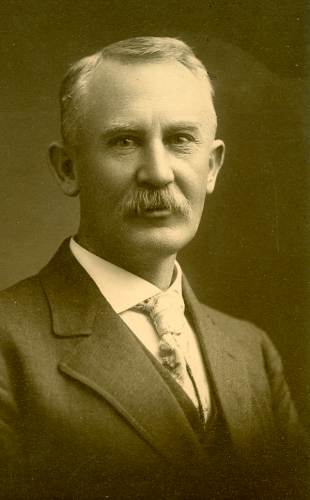
01 J. R. Wells
Not only was he the first president of the Anchor Milling Company of Tuscumbia,
but he also was known for the steamboat named after him by the Anchor Milling Company, the "J.R. Wells" (photo 02).
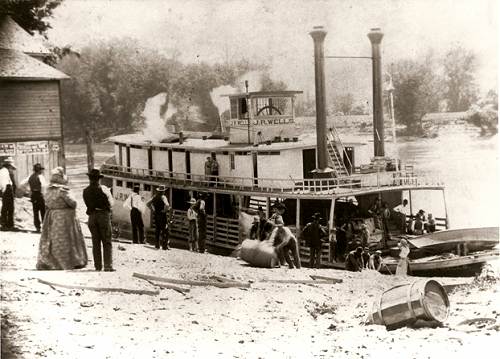
02 J.R. Wells unloading at Tuscumbia We have already uploaded on our website significant information about J.R. Wells
the man, as well as J.R Wells the steamboat, and I would suggest you might want to read it
now to get an overview of his life before continuing with this narrative where I have
explored in some detail the story of the Wells family. The first article on our website is
a short summary of the story of the large Wells home:
Wells
House - Miller County Museum & Historical Society
The second article is a summary of the life of J.R. Wells. You will find it on our
website at this location (you will need to scroll a short way down the page to get to
Joshua R. Wells):
W -
Biographies of Miller County Persons
I was raised in Tuscumbia and had heard about J.R. Wells all my life. I knew fairly
well one of his daughters, Sue Wells Stillwell, whose home was next to the Tuscumbia High
School (removed several years ago when the expansion of the high school occurred). My
mother was friends with some of the Wells grandchildren and had played with them in the
large home on the river farm. But I never had familiarized myself with many of the details
of the Wells family, especially J.R. Wells, of whom we could not find in our museum a
single old photo to let those of us who were too young to have seen him to know what he
looked like. So, I called Roy Sone, one of the last living grandchildren of J.R. Wells,
who lives in Jefferson City, and asked him if I could come over and scan some pictures and
get further history about the family. Last week on a sunny warm day I made the trip from
Tuscumbia to Roy's house.
Roy and Joyce, his wife (photo 03),
live in a very picturesque home overlooking the Moreau River south of Jefferson City (photo 04).
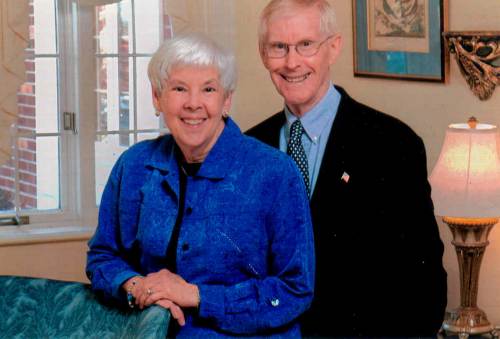
03 Joyce and Roy Sone

04 View South from Roy' s Home He met me at the door and helped me carry some of my scanning equipment into the
dining room where on the dining room table he had gathered for me all the Wells family
history and genealogical books as well as numerous photo albums. I spent about five hours
talking with Roy and scanning photos and documents. Joyce was such a nice hostess; she
made fresh muffins and coffee for me when I arrived and later prepared a delightful lunch
for Roy and me!
Before delving into the Wells' side of his family, we discussed some of the interesting
history of Roy's paternal family, the "Sones." One of Roy's distant relatives of
the past, Samuel Sone (photo 05), had
been sheriff of Cole County at one time.
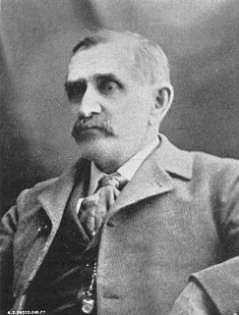
05 Samuel H. Sone Samuel also had a connection to Tuscumbia in that he was married to Lena
Hauenstein, daughter of William Hauenstein, the first of the Hauenstein family to come to
Tuscumbia. Lena had died early on in the marriage, and her son, Will, who later became a
dentist, spent much of his early life visiting his Hauenstein grandparents in Tuscumbia.
Samuel Sone had an interesting history with other connections to Miller County in addition
to his wife. The Cole County Historical Society includes this short biography of Samuel:
Samuel H. Sone was born on a farm near Jefferson City
February 16, 1848. He lived there until the age of twenty-one when he secured the contract
for carrying mail from Jefferson City to Tuscumbia, the county seat of Miller County. He
ran a stage for ten years.
He was united in marriage on August 10, 1876, to Miss Lena
Hauenstein of Tuscumbia, after which he engaged in farming. When his wife died a year
later, he engaged in the livery business in Tuscumbia for three years when he got into the
real estate business in Aurora Springs. He then moved to Kansas City where he stayed
awhile then came back to the Cole County home of his early life. Here he was deputy
sheriff four years under T.B. Mahan, four years under F. J. Fromme. In 1894 he was elected
to the office of sheriff and re-elected in 1896. At the expiration of the second term he
moved to his farm west of the city.
He had a son (Will) by his first marriage. Mr. Sone
married a second time to Mrs. Elizabeth Jenkins (nee Stone) a grand-daughter of the Rev.
John West, minister of the Old School Baptist Church. As a result of this union he had
four daughters. The family lived at 1400 West Main Street.
Roy Sone's father, Guy, was an interesting person himself having been a respected
Jefferson City golf player who played often with some of the well known pros of the day (photo 06).
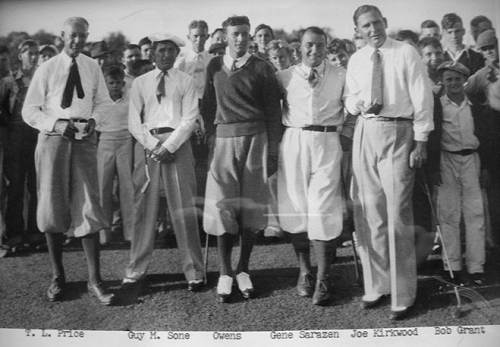
06 T. L. Price, Guy Sone, Owens, Gene Sarazen, Joe Kirkwood and Bob Grant Roy kept some of the interesting artifacts from the Wells family home in
Tuscumbia. One of these is an old mantle clock brought by the family from Virginia (photo 07). Another is a passenger ticket (photo 08) for an old steamer, The Planter,
owned by his great grand father Charles.

07 Clock brought from West Virginia
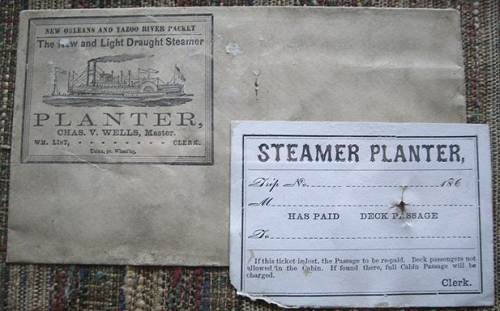
08 Ticket for Steamer Planter
Roy also has the original plans for the Ruth (photo 09), a steamboat his grandfather J.R. Wells had
constructed and named for his daughter named Ruth, whose name had been drawn from a hat from
among the names of her sisters also placed in the hat. An old ceiling lamp brought from
the Wells house hangs from the ceiling of Roy's dining room (photo 10). One particularly interesting item is an antique
spy glass (photo 11) owned by Charles
Wells, Roy's great grandfather, who ran steamboats on the Ohio River.
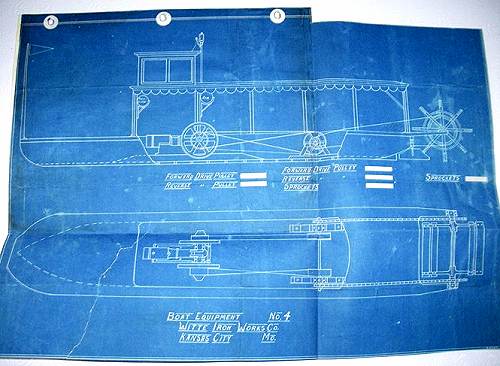
09 Plans for Ruth
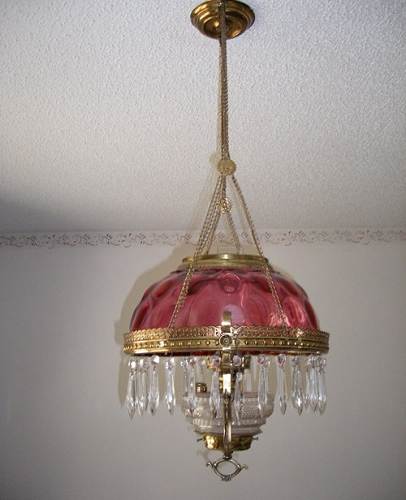
10 Hanging Lamp from Wells House

11 Spy Glass used by Charles Wells Roy also has some paintings done by two famous Miller County artists, John Wright
and his daughter, Francis Wright. The Wells home was reproduced in an interesting painting
by John Wright finished sometime in the very early 1900's or perhaps before (photo 12). In this painting, John hid the
names of the seven Wells children but with careful searching one can find them. The
painting by Francis (she later used the professional name of Francesca) was of the famous
Wells steamboat, the J.R. Wells (photo 13).
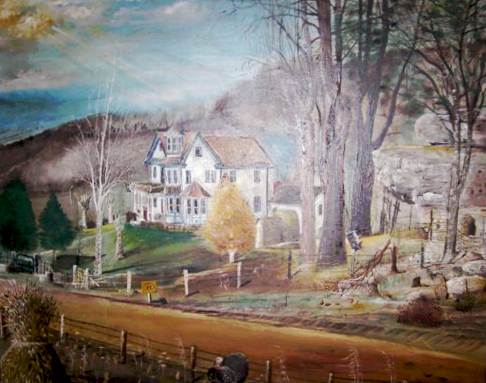
12 Wells House Painting by John Wright
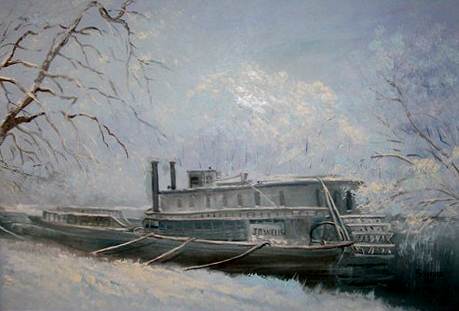
13 J.R. Wells Steamer Painting by Francesca Wright Roy's mother, Ruth, was the historian of the family who researched and wrote the
Wells family history tracing the lineage back to the late 1600's in Maryland. It is from
her book, which Roy loaned me, that I have copied the stories of Charles V. and Joshua
Russell Wells. The only photo I could find of Charles V. Wells had been copied into a
short biography of him which I include here before beginning the longer biography of
Charles written by Ruth (photo 14).
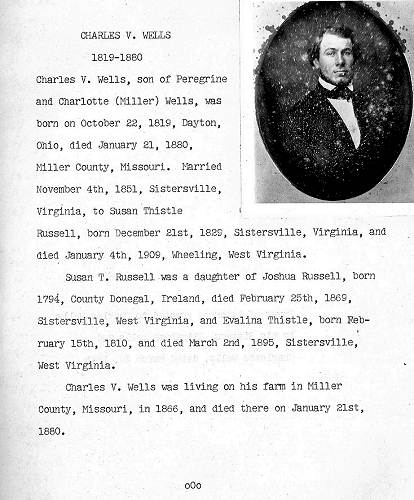
14 Charles V. Wells Bio
Click image for larger view And now the story of Charles V. Wells as researched by his granddaughter, Ruth
Wells:
Charles V. Wells
By Ruth Wells Sone
Charles V. Wells was born October 22, 1819, in
Dayton, Ohio, the son of Peregrine and Charlotte (Miller) Wells. Charles's Mother,
Charlotte, died in Ohio when he was about three years old.
Peregrine, after the death of his wife, returned to Tyler
County, Va. (Now Tyler County, W. Va.) with his three children, Elizabeth, Charles and
Charlotte. Peregrine then married Mary Braley in Virginia, January 6, 1823. In the fall of
1824 he built his home on his "Long Reach" property, willed to him in 1815 by
his father, also named Charles. This land located only a few miles south of Sistersville,
W. Va., was known as "Long Reach" because it is said to be the longest and
straightest stretch of river in the Ohio Valley.
The house was built on a knoll overlooking the valley and
river, and in 1937 was the home of Miss Molly Wells, a grand daughter of Peregrine and
Mary (Braley) Wells. Charles Wells early in life had an opportunity to know the river and
create an interest in navigation, as well as the value of river bottom land.
On March 30, 1842 Elizabeth and Charlotte Wells gave their
brother, Charles Wells, Power of Attorney to handle or dispose of property inherited by
them from the Estate of James Miller, their mother, Charlotte (Miller) Wells, having died
intestate. Charlotte (Miller) Wells was a daughter of James Miller and Rebecca (Wells)
Miller.
The purchase of land was the usual custom of investing
money at that time. So, it would seem that it was with this inheritance Charles bought
land in Miller County, Missouri. On April 28, 1842 Charles Wells purchased land in Miller
County, Missouri, as shown from a Warranty Deed from Andrew McCastland and Mary
McCastland, his wife, to Charles V. Wells of Tyler County, Virginia.
Charles had come to Missouri with Nicholas Wells, an
uncle, of Tyler County, Virginia, who also purchased land along the Osage River in Miller
County, Missouri. According to a Tax Receipt among his papers, Charles paid taxes in 1843
in the amount of $3.12 on the 185.06 acres purchased in April, 1842.
The next tract of land acquired in Miller County, Mo. by
Charles, was on October 13, 1855, when he entered 320 acres, adjoining the land purchased
in April, 1842. This tract was patented April 2, 1857.
On April 25, l861, he purchased at Sheriff's Sale in
Partition 144.92 acres in Miller County, Mo. This land also joined the other plots.
Tax receipts for 1876 show taxes paid on 644 acres in
Miller County, Missouri.
Charles married November 4, 1851, in Sistersville,
Virginia, (now West Virginia), Susan Thistle Russell.
In 1860 Charles brought his wife, Susan, and their seven
year old son, Joshua Russell Wells, to Miller County, Missouri for a visit, so that they
could see the farm and observe the beautiful virgin country in which it was located.
The next several pages of Ruth Wells Sone's history of the Wells family details the
history of Charles V. Wells' business activities in Virginia during the years 1846 until
1867 when he returned to his Missouri Miller County farm to live. I will summarize what
Ruth wrote as follows:
In the pre Civil War years, Charles Wells was very successful running steamers up and
down the Ohio and Mississippi rivers carrying freight of all kinds including cotton. At
various times he owned up to five or six steam boats. But when the Civil War began
President Lincoln ordered a blockade on the Mississippi to isolate New Orleans.
Undeterred, Wells and other steamboat owners were able most of the time to run the
blockades due to the inferior quality of the Union Army's gun boats which could not
intercept them with regularity. However, as time went along, the North's gun boats
improved in quality as did the skill of their captains and the Southern steamers began to
be captured and destroyed.
At the close of the Civil War Charles Wells and Company owned a large number of bales of cotton
costing $61,717.90 which was stored in a warehouse. But Wells could not sell the cotton
since he had not taken the "Amnesty Oath" and was still considered a
"Rebel." Even though he spent almost a year engaging attorneys and other
consultants to take possession of the cotton, all efforts failed. Thus, in 1866 he found
himself without his steamboats which had been captured or destroyed, and without any of
his stored merchandise being returned to him. Depressed and despondent he decided to leave
his family with his father in law, Joshua Russell, and return to his Miller County farm to
try to regain his financial losses.
Now I'll go back to the narrative by Ruth Wells Sone which tells the story of the
activities of Charles Wells in Miller County Missouri:
CHARLES V. Wells in Missouri
Charles V. Wells did not return to his home in
Sistersville, West Virginia after losing his boats and cotton in the south, instead he
went to his 644 acre farm in Miller County, Missouri. He brought with him books, papers, a
tool chest, tools, drapes, which had been used on the steamer Planter, a spyglass and
several other articles he had salvaged from his boating days, to make his home in a large
log cabin (photo 15) in a wooded section of the farm.
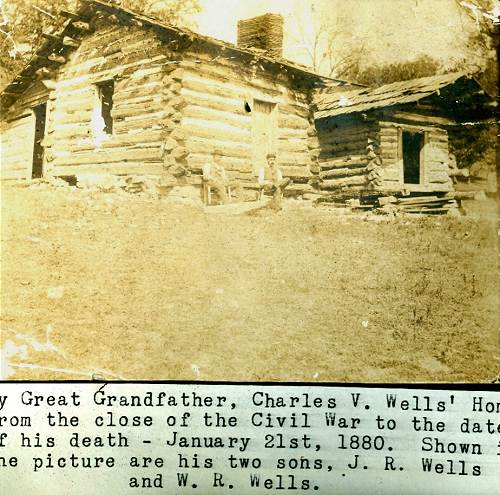
15 Charles Wells Log Home He had spent his boyhood on a farm in the Ohio
Valley in Virginia. The knowledge obtained there and his determination was all he had to
commence a new life as a farmer in Missouri.
His wife Susan and their four children continued to make
their home with her father and mother in Sistersville, West Virginia.
Note: here is a family photo of Charles V. Wells before he left Virginia: (photo 16).
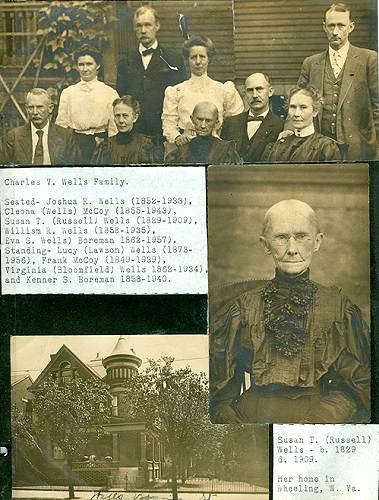
16 Charles V. Wells Family The following quotation from a letter written by
Joshua Russell reflect his affection for his son-in-law:
Sistersville, W. VA
September 17, 1867
Dear Charles,
We would all be glad if you could come home. I suppose Susan has or will soon be writing
to you and give you all the news. Hoping you will yet have better fortune than you have
had heretofore.
I remain as ever,
Affectionately yours,
Joshua Russell
The first task Charles had after settling on the farm was
to clear more land and sell the timber. On December 28, 1874, he sold timber to M. S.
Carter of Osage City, Missouri. The contract stated: "... the said M.S. Carter agrees
to pay Four Dollars per 1000 feet for all the Saw Timber in the above Boundary to be
measured on the bank of the river bank of the River at C. V. Wells Landing and pay as soon
as delivered in raft at Osage City, to be run as soon as possible as the water will
admit."
Wells was forced to file a suit to collect for the timber.
Judgment was awarded in his favor in the sum of $309.84, on December 13, 1876.
Charles had freighted many bushels of potatoes while in
the steamboat business. Therefore, it was only natural that when he was looking for a cash
business and one that he knew how to market, he would raise potatoes. Then too, he had a
boat landing for a convenient loading place. He was known in the neighborhood as
"Potato Charley." A survey made by H. S. Burlingame, Deputy Surveyor of Miller
County, Missouri, of the potato field showed 5.18 acres. The date is not given on report
of the survey.
When making his three mile trips to Tuscumbia he often
walked, taking a steer hitched to a cart to haul his wares to and from the village.
He raised wheat, corn, hay, etc. on the farm. In April,
1879 he rented forty-two acres of ground for corn by contract: fourteen acres to David
Hawken, sixteen acres to James Simpson and twelve acres to Benjamin F. Lawson. The new
friends in Missouri knew little about Charles V. Wells, excepting that he had been a
steamboat man. He was a member of the Odd Fellows Lodge of Tuscumbia. Wells made provision
for a bountiful supply of food for the winter as shown by the supply on hand at the time
of his death in 1880. The circumstances as to the cause of his death are not clearly
known.
William Hauenstein of Tuscumbia, Missouri, a very good
friend of C. V. Wells wrote the following letter to Mrs. C. V. Wells at the time of the
death of her husband:
Tuscumbia, Mo.
Jan. 22nd, 1880
Mrs. Wells
Dear Madam:
I here with inform you of the death of your husband, Chas. V. Wells. His spirit took its
flight last night 20 minutes before 11 o'clock at his Farm.
With easy mind he past away in a pleasant sleep to awaken
no more.
His sickness was Pneumonia, the burying will take place
here tomorrow afternoon. As a friend I have done all in my power through his sickness and
his Farm and stock shall have my attention until in the hands of an Administrator. I will
write to you in a few days in what way the personal property will be disposed of.
Yours Respectfully,
William Hauenstein
Mr. Louis Hawken and Mr. Al June were with Wells at the
time of his death. He was buried in the Tuscumbia Cemetery, at Tuscumbia, Missouri.
Mr. Hauenstein was appointed administrator of the estate.
Charles V. Wells died intestate, and the sale of his
personal property was held on February 6th, 1880, at the farm. It is interesting to note
the amounts of food listed as sold at the sale of February 6th:
Bacon, 2 boxes onions, 3 boxes of beans, 2 barrels of
salt, keg of molasses, lard, 1 barrel meal, ½ barrel of kraut, 1 box pop corn, and l24
bushels of potatoes, also barrel of soft soap.
A list of his live stock shows: Chickens, ducks, hogs,
yoke of oxen, yoke of steers, a pair of yearling steers, cows, heifers, bull calves, and
sheep. No horses listed.
Some of the items sold at the sale are as follows:
Harrow, iron maul, 4 live oak mauls, crow bar, plows, ox
bows, ox yoke, scythes and corn knives, grind stone, shovels, spade, hoes, rakes, trough
axe, mattock, pick, hay fork, manure fork, saws, single tree, tool chest, brace and bits,
files, chisels, planes, hammers, augers, square, wrenches, log chains, etc.
The next part of Ruth's history tells the story of how J.R. Wells, Charles' son, came
to live on and work the farm of his father in Tuscumbia. But first, I want to add some
additional history about Charles obtained from descendents of one of his tenants, Lewis
Jones, who leased land from Charles early on soon after Charles arrived in Miller County.
The information was obtained from a history written by Hazel Pearl (Jones) Uthoff, a
descendent of Lewis Jones. I am indebted to Hazel's son, Vincent Uthoff for giving
permission to record what his mother wrote. The interesting aspect to me of this short
story is that Lewis Jones had, like Charles Wells, been a rich man in Virginia, lost
everything due to the Civil War and a prewar "panic," and then traveled to
Missouri and Miller County to try to recover financially:
Lewis B. Jones
Hazel (Pearl) Jones Uthoff
Lewis B. Jones (B 1802, D 1874) was one of 10 children born
to Thomas H. (B 1782 D 1849) and Mary Haines (B 1785 D 1872) Jones. Lewis was born in a
wilderness area of Virginia near the present day city of Middlebourne, West Virginia. At
the start of the Civil War, when Virginia withdrew from the Union; the western counties of
Virginia withdrew from Virginia and were admitted in 1863 to the Union under the name West
Virginia. In the late 1820's Thomas bought a tract of land on the Ohio River near
Sistersville. Thomas became a merchant-farmer and sold produce and cured meats to the
riverboats that carried passengers and cargo along the Ohio River.
On August 1824, Lewis B. Jones, son of Thomas, married his
first wife, Rebecca Haines. In 1838, Rebecca died. Lewis later married a second time. His
second wife was Elizabeth Custer. She bore him 5 children.
When Lewis's father died in 1849, Lewis bought out the
other heirs and started a lumber business on Mckim Creek in what is now Pleasants County,
West Virginia. At one time his holdings included 17,000 acres of land, a sawmill, a store,
and a boat building company. During the "Panic of 1857," Lewis lost most of his
holdings. What he was able to save, he divided among the children of his first marriage.
Lewis then moved West seeking to recoup his fortune. The
children of his second marriage came with him to Miller County, Missouri. Charles Wells,
who operated boats on the Ohio, and with whom Lewis's family had been associated in
western Virginia, owned 900 acres of land on the Osage River near Tuscumbia, Missouri.
Charles wanted it cleared and fenced. Lewis agreed to a 3-year lease to a parcel of land,
which he would clear and fence in return for the lumber he would remove from the land. The
brother of Elizabeth Hill had a similar lease on the Wells property, and this was how she
and Lewis met.
Lewis and Elizabeth remained on the Charles Wells Farm for
about 10 years. During these years, 4 children were born to them: William Lewis Jackson,
Eliza, Ulysses Grant, and Virginia. About 1869 Lewis moved his family from the Charles
Wells farm to a 311-acre farm on the Osage River near Capp's Landing. Only about 100 acres
were farmable, the rest was rough and woodsy. Lewis had purchased the farm with $1,800
saved from the sale of lumber. Lewis farmed and sold cured meat, like his father before
him, to commercial riverboats.
When Lewis lived in Pleasants County, Virginia (since
1863, part of West Virginia), he had co-signed notes of others to help them obtain loans.
About 1873, he was asked to make good on one of these notes. In February of 1874, Lewis
drove some hogs into Tuscumbia to raise the money to pay the note. He returned home about
midnight with pneumonia and died before morning. Elizabeth Hill was left a widow for a
second time. She had 4 children still at home, Nancy 18, Billy 14, Grant 9, and Virginia
7. Eliza had died about 4 years before and the other children were married and on their
own.
About 1877, some 3 years after Lewis's death, Elizabeth
lost the farm on the Osage River. "Cheated out of it," Grant said. And 7 years
of wandering began -- looking for someplace to start over again. Billy took a job driving
a Mr. Diamond and a Mr. King, who owned a Punch and Judy show, to Texas, and the family lost track of him for
several years. The family moved first to Cherokee County, Kansas, to Northwest Arkansas
near Grant's half-brother Mark, then to Joplin, and St. Joseph, Missouri. Finally
Elizabeth moved back to Miller County. During the time of wandering Elizabeth supported
herself as a midwife. Grant took whatever came to hand, splitting cordwood, helping drive
cattle to market, or helping a farmer bring in his crops. Grant said,"I was never
too little for the big jobs or too big for the little jobs. I often took jobs that others
were too proud to do. We were poor, but I never went hungry or cold. There is no shame in
being poor. The only thing wrong with being poor is the disadvantages it brings you."
Another descendent of Lewis Jones is Sharon Balow. In 1971 she visited the Wells farm
and interviewed Colonel William Wells, grandson of Charles and son of J.R. Wells, who was
temporarily visiting the farm to deal with some estate issues after it had been sold:
Colonel William Wells' Memories
Sharon Balow
In visiting the Charles Wells Farm in June of 1971 my
husband talked with Colonel William Wells, Air Force Retired, and a grandson of Charles
Wells. The farm had been sold at that time and the new owners had already moved in but
Colonel Wells was there to move out any remaining personal property not included in the
sale. He pointed out the foundation of the original house on the property, the spring
house that was used for fresh water in the original house, the original location of the
present farm house with the fountain curb still in place and one of the original log
cabins that had served in the early years as a home. He recalled
for us some of his experiences as a boy while living with his father, Joshua Russell
Wells, who had inherited the land from his father, Charles Wells. Colonel Wells told how
as a boy of 7 or 8 his father would permit him to take trips with the steamboats. As the
steamboat passed the Wells Farm his father would hand him up to the deck and he would ride
the boat to its destination and return to the farm when the boat make a return trip in a
week or so. Colonel Wells related that his grandfather, Charles Wells, had come to Miller County, Missouri after the Civil War in 1866. He had lost his stocks in the steamboats during the Civil War and his Missouri farm was the best prospect for regaining his fortune.
Now to return to the Wells' history by Ruth Wells Sone in which she tells the story of
her father, J.R. Wells:
Joshua Russell Wells
Ruth Wells Sone -- 1955
Joshua Russell Wells, the son of Charles V. Wells and
Susan T. (Russell) Wells, was born on December 31, 1852, in a large brick house, built by
his Grandfather, Joshua Russell, on Catherine Street, Sistersville, Virginia, now West
Virginia. This home was a very large colonial style house, being seventy feet across the
front, with a fire place in each room for heating. The slave quarters were situated at the
back of the lot. It is quite evident that the Family of Charles V. Wells had all the
conveniences the times afforded.
At the age of seven years Joshua Russell Wells made a trip
to Missouri with his parents. It was a common occurrence for members of his family to make
trips on the rivers with Charles V. Wells as he pursued his business along the Ohio,
Mississippi and other rivers.
The following extract is from a letter written by Mr. John
Handford McCoy of Sistersville, West Virginia, on March 19th, 1937, to Mrs. Guy (Ruth
Wells) Sone:
"We always called your father 'Jock'. I presume he
was named after his Grandfather Joshua Russell, but we always called him 'Jock'. "He
was one of my favorite boy companions and although we all called his mother "Aunt
Sue" as far as I know we were not related. Your father and I went to school together,
played the games we played at school in those days and we also played side by side in the
Sistersville Cornet Brass Band, the first band that was organized in this town.
The good Lord never made, to my mind, a finer, cleaner and
more honorable chap than Jock Wells. He was liked by everyone, old, young, middle aged,
rich or poor, and was a favorite with the girls, but he never seemed to care for the
girls. If he ever had a real or "Puppy Love Affair" I have forgotten it."
Hanford McCoy was a descendant of Sarah Wells, one of the
"Twenty Two." His wife was a Wells, who descended from Eli Wells, another of the
"Twenty-Two. In a conversation in his office in Sistersville, W. Va., in 1935, he
stated to me:
"It would set you crazy to figure out the Wells,
McCoys, Russells and Thistles as they married and intermarried."
With which statement I most certainly agree. The
troublesome times of the Civil War Period altered the home life of the family, and
following the war, with their father's boating business lost and his means of livelihood
destroyed, it was necessary for Joshua Russell Wells as he became old enough, to plan some
means of preparing for the future. He was an apprentice for four years to a saddler. He
was engaged in business, 1875-1876, in Wheeling, W. Va., at 1512 Main Street, under the
firm name of Altmeyer & Wells, Commission Merchants and Dealers in Country Produce. He
became interested in steam boats and worked with Capt. Charles B. Russell. In 1878 during
the yellow fever epidemic in Memphis, Tennessee the boat on which he was working was
quarantined there, and during which epidemic there were 4,204 White persons and 946
Negroes who died.
'Jock' (his commonly used nickname) Wells was bothered
with rheumatism while on the river and for that reason, returned to his saddlery trade. In
1880 he was engaged at his trade in St. Louis, Missouri, endeavoring to save enough money
to move on to Texas and establish a business there. However, his father Charles V. Wells
died on January 21, 1880, on his farm in Miller County, Missouri.
William Russell Wells, the youngest son of Charles V.
Wells, left Wheeling, West Va. on February 2, 1880, with a letter of introduction from his
mother, and upon arrival in St. Louis, contacted his Brother Joshua and the two proceeded
to Miller County, Missouri, arriving there on February 6, 1880.
The sale of the personal property of Charles V. Wells had
been advertised for February 6th, and said sale was in progress when the two sons arrived.
Joshua Russell Wells remained on his father's farm, and William Wells returned to Wheeling
early in 1880. After altering his business connection in Wheeling, he again returned to
Miller County, making the entire trip by boat, and bringing his riding horse and a tool
chest. He landed at the Wells landing on the farm in Miller County, Missouri.
Charles V. Wells having died intestate, the farm was
inherited by his widow and the four children. The two boys, Joshua and William, decided to
do business as the Wells Bros. Their first aim was to buy the interest from their mother
and two sisters, which was accomplished in a few years.
Benjamin F. Lawson (our maternal grandfather) had rented
corn ground the year before from Charles V. Wells, and in 1880 he also rented corn ground
from the Wells Brothers.
In early 1880 Benjamin with his wife Ellen Tarbutton
Lawson and two daughters, Lucy and Emma, moved to a log house on the Wells Farm.
On December 1, 1880 the Wells Bros. leased ground to be
cleared to Samuel H. Bell and S. P. Jones for three years. On December 1, 1881 leases for
ground to be cleared were given to Benjamin F. Lawson, Albert June, and Jonathan and
Simpson Willis. On December 1, 1889 a lease was made to Emanuel Willis to clear the ground
known as the "Saline Bottoms." The terms of the four year lease were:
"The parties are to clear and cultivate one third of
the ground or more the first year, one half or more the second year, and all to be
cleared, fenced and in cultivation at the end of the third year, to give up the ground at
the end of the fourth year with a fence, eight rails high, stake and ridered and good
rails."
During the winter of 1880-1881 the logs were cut and
"Snaked in with oxen" for a big barn, and which barn is still in use at this
time (1955).
(Note: Roy Sone told me the barn burned about twenty years ago)
Up until the barn was built in 1881, only a covered shed
was used for shelter for the stock. The timber, as it was cleared from the land, was sold
for lumber or made into railroad ties. The ties were made into rafts and floated down the
Osage River to Osage City, Cole County, Missouri. In 1885 the Wells Bros. were renting
ground for a grain rent. Some of the renters were Jim Bell, Charles Cox, and Lewis Hawken.
In the "History of Cole, Moniteau, Morgan, Benton,
Miller, Maries and Osage Counties of Missouri, IV by the Goodspeed Publishing Company,
1889, pages 622, 823, appears the following:
"The Wells Brothers have during the last seven years
cleared up 150 acres of this land, and now have 250 acres under cultivation. They own 640
acres in the tract. They are now just completing a handsome two story residence (photo 17), and
are doing most of the work themselves."
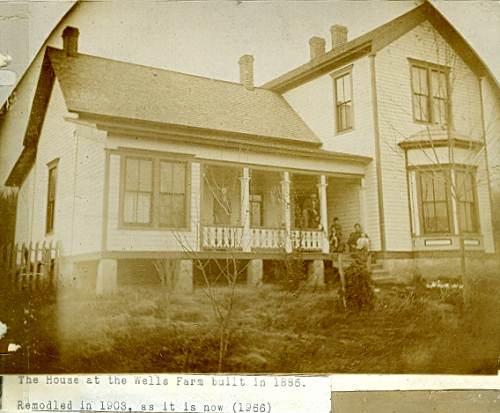
17 Wells Home - 1886 Susan T. Wells and Evelina (Thistle) Russell of
Sistersville, W. Va., mother and grandmother of the Wells brothers, spent the summer of
1890 with them in their new home on the farm.
Thereafter William Russell Wells returned to Wheeling, W.
Va., where he opened a leather goods store.
Lucy Ellen Lawson (photo 18), the daughter of
Benjamin F. Lawson and Ellen (Tarbutton) Lawson, born June 26. 1873, in Miller County,
Missouri, was married to Joshua Russell Wells, February 25, 1891, in the home of the
bride.
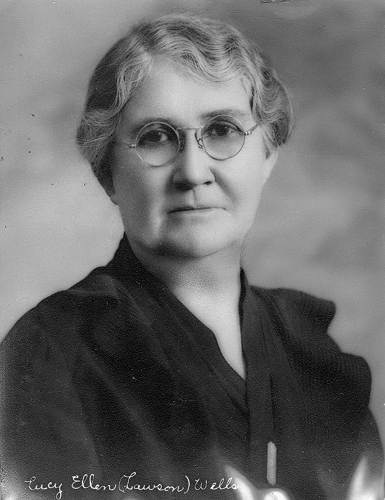
18 Lucy Wells This is the announcement of the wedding in the local
papers:
WELLS-LAWSON
Mr. "Jock" Wells and Miss Lucy Lawson
were married at 10 o'clock yesterday, the 25th, at the residence of the brides Parents. L.
E. Melton officiated. Mr. Wells is wealthy and Miss Lucy is handsome.
The Eye Opener extends the hand of congratulations
(The Vindicator: Tuscumbia, February 26, 1891).
FAMILY OF JOSHUA RUSSELL WELLS AND LUCY ELLEN (LAWSON)
WELLS
1. Joshua Russell Wells was born December 31st, 1852,
Sistersville. Virginia, died November 25, 1933, Miller County, Missouri, (buried Riverview
Cemetery, Jefferson City, Mo.), married on February 25, 1891, to Miss Lucy Ellen Lawson,
born June 26. 1873, Miller County, Missouri
a. William Russell Wells, b. July 13, 1892, Miller County,
Mo., married on June 4, 1925, Los Angeles, California, to Ruth Short, born November 11,
1893, Jefferson City, Missouri.
b. Susan Ellen Wells, b. December 15,1893, Miller County,
Mo., married first on June 6, 1920, at Jefferson City, Mo., to Calvin Speedy, b. June
6.1900.
b. Susan Ellen Wells Speedy married second on December 27,
1936, Jefferson City, Mo. to Walter S. Stillwell, b. June 27, 1879, Harrison, Ark., d.
January 18, 1953, Tuscumbia, Mo.
c. Ralph V. Wells, b. February 22, 1895, Miller Co., Mo.,
married on November 11, 1920, St. Louis, Mo., to Mildred Stadler, b. November 27, 1893,
Jefferson City, Mo.
d. Lucy Wells, b. January 14, 1898, Miller Co. Mo., married
on August 15, 1935, Miller Co., Mo., to Richard Dalton Fowler, b. March 20, 1893,
Jefferson City, Mo.
e. Ruth Wells, b. November 7, 1899, Miller Co., Mo.,
married September 11, 1932, Jefferson City, Mo., to Guy M. Sone, b. January 6, 1893,
Jefferson City, Mo.
f. Joshua Russell Wells Jr., b. October 21, 1901, Mi1ler
Co. Mo., married on May 22, 1927, Albany, Mo. to Loraine Twedell b. June 6, 1904, Albany,
Mo.
g. Edith Wells, b. March 7, 1903, Miller Co., Mo., married
December 27, 1934, Jefferson City, Mo., to Alfred Felix Senevey, b. November 2, 1901,
Bonnets Mill, Mo.
The Wells Bros. added more land to their farm from time to
time:
May 9, 1894 - 40 acres.
April 10, 1897 - 3.50 acres.
August 8, 1901 - 40 acres.
On June 29th, 1928, William Russell Wells deeded his share
of the farm to Joshua Russell Wells, - the deed reciting 733-1/2 acres- J. R. Wells
relinquishing certain interests in joint holdings to W. R. Wells in West Virginia.
The Wells Brothers were interested in community affairs in
Miller County, Mo. When the Anchor Milling Co. was organized they purchased stock and
Joshua R. Wells became the first president. The Anchor Milling Company in 1898 bui1t a
steam boat, which was named the "J. R. WELLS" (photo 19).
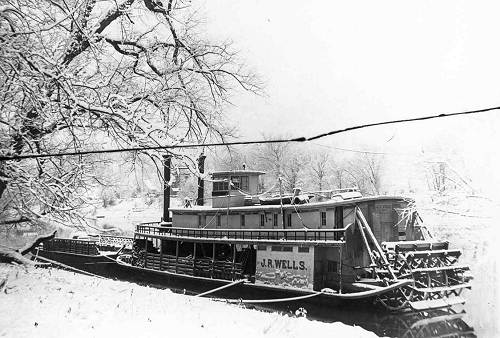
19 J.R. Wells It was launched on January 14, 1898, the day his
daughter Lucy was born. The Treasury Department, Bureau of Customs, St. Louis, Missouri,
describes the Steam Boat J. R. Wells, as follows:
"The list of merchant vessels for the year 1898 lists
a steam paddle wheel (rear wheeler) called the J. R. Wells, Official Number 77,288, built
in Tuscumbia, Missouri, in 1898, with St. Louis, Mo., as home port. She was 110.6 feet
long, 20.6 feet wide and 4 feet deep. She measured 206 gross tons and 130 net tons. Other
records indicate that The Anchor Milling Company of Tuscumbia, was the owner and in March,
1909, one P. F. Hauenstein was Master. In August, 1909, She was sold to A. G. Thompson and
R. O. Shobe of Chamois, Mo., and Captain Thompson is shown as Master."
In 1902 the house on the farm was remodeled into a three
story frame building with two large rooms on the third floor (photo 20). Water was piped from
a b1uff spring, far back on a hill into a reservoir, then from the reservoir to the house,
at a cost of $220.00. A furnace was installed the following summer and which was used
until the house was moved in 1949.
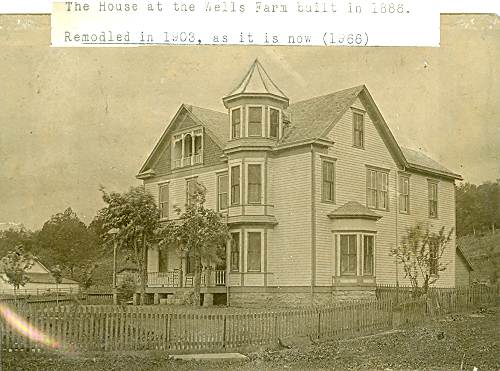
20 Wells Home Remodelled - 1903 J. R. Wells had not lost his interest in boats and
in 1908 he built a new boat. To select a name for the boat, he requested his daughters to
draw straws and Ruth being the lucky girl, the boat was named 'The Ruth' for her (photo 21).
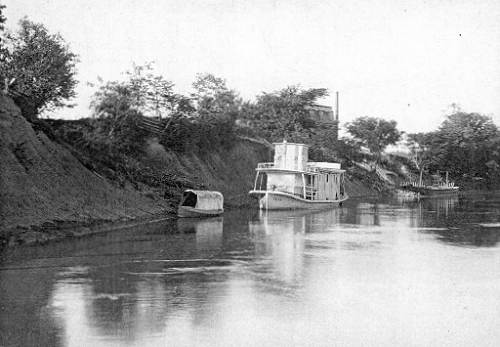
21 Ruth at Mill The Treasury Department, Bureau of Customs, St. Mo.
gives the following information on 'The Ruth':
"In the 1908 record there is listed 'a gasoline
turbine steam yacht RUTH, Official Number 205,657, with register dimensions of 52.5 by
12.2 by 3.0. Her indicated Horsepower was 25 and she was built in 1908 at Tuscumbia. Her
home port was St. Louis, Mo, and her first document was Permanent Enrollment No. 3, which
was issued at St. Louis, Mo., on September 12, 1908 to J. R. Wells as owner. A record
around 1914 indicates that this vessel was then owned by the Anchor Milling Company.
(Here is a photo showing the expenses for
building the Ruth, photo 22).
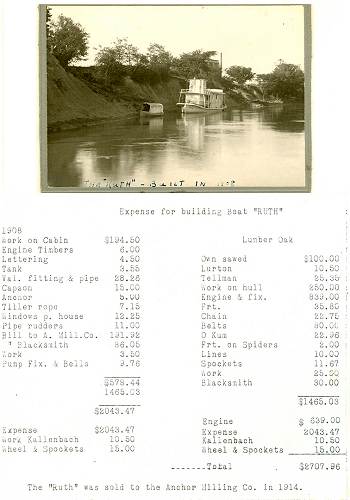
22 Expenses for building Ruth
Click image for larger view The Ruth was sold about 1921 to the Speedy Box
Manufacturing Company and was lost in 1924, probably sunk. All boats that traveled the
Osage River would whistle when they passed the J. R. Wells Home
J. R. Wells and his family lived about two miles from the
Wright District School (photo 23), which made it difficult for the children to attend regularly.
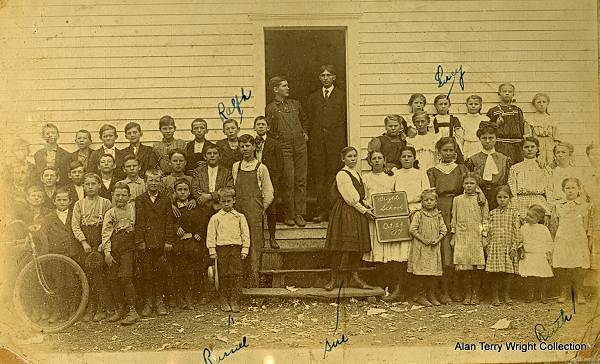
23 Wright School Class in front of Building
Click image for larger view In the fall of 1909 Mr. and Mrs. Wells employed a
Governess for the children and one of the rooms on the third floor of their home was
furnished as a school room after which for the next two years their children attended
school at home.
In the summer of 1911 Mr. Wells built a home (photo 23a) in
Jefferson City, and moved there in August of that year, in order that his children might
have the advantage of the city schools. He bought a significant amount of land on West
Main Street, six lots in all, five of them extending down to the Missouri River.
Eventually, three other homes were built next to the original one by his children who
lived there as adults.
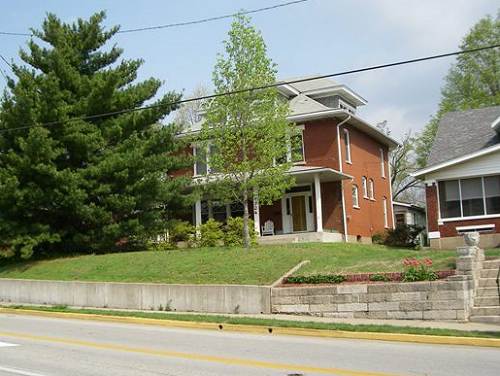
23a 1324 W. Main - J. R. Wells Home in Jefferson City In making the move to Jefferson City "The
Ruth", with a barge, was tied up at the "Wells landing", and all the
articles to be moved were loaded on the boat there and freighted by boat to Jefferson
City. Very little furniture was moved, as the farm house was left completely furnished.
At the close of the school year in the spring the family
would return to the farm for the summer, and then back to Jefferson City for the school
year.
In the summer of 1933, the members of the family who were
single, returned to the farm and remained there during the last illness of their father,
Joshua Russell Wells. He died at the farm on November 25, 1933, and is buried in Riverview
Cemetery in Jefferson City, Mo. His will is filed of record in the Office of the Probate
Court of Miller County, Missouri.
The residence at the farm was moved during the fall of
1949 from its original location to higher ground because of the increasing number of
floods on the Osage River after the construction of a power dam at Bagnell, Missouri, by
the Union Electric Company.
Roy Sone and his wife Joyce spent the first few years of their marriage living in the
J.R. Wells family home in Tuscumbia. It was sold with the farm in the early 1960's but the
home has been a landmark for many years and even today offers an impressive appearance
located at the base of a hill some distance from Highway 17 in a small valley. Here is a
photo of the home taken after its remodeling sometime after 1903 (photo 24).
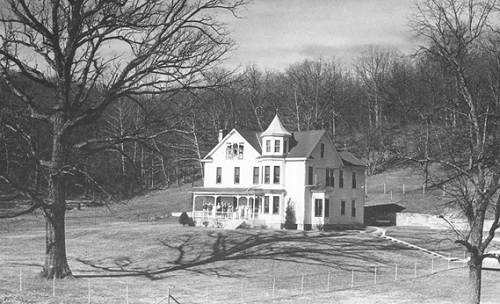
24 Wells Farm Home Before touring the home with Mrs. Sone (Joyce) via an article published in the
Autogram in 1961, I want to give some details about the history of the house summarized by
Ruth Wells Sone, Roy's mother. This summary is taken from our own website to which I
alluded at the beginning of this narrative (Wells
House) but is copied here for convenience:
Wells Farm Home
Ruth Wells Sone
On the Osage River, near the town of Tuscumbia, sits the
Wells House, possibly the first residence in Miller County equipped with running water and
indoor bath facilities. The house was built in 1889 by J.R. Wells, whose father, Charles,
had homesteaded the farm not long after arriving in Missouri from Wheeling West Virginia.
Charles lived in a small log cabin he found on the farm
until his death. At that time his sons, J.R. and William, came from West Virginia to
settle their father's affairs. William remained only a short time, but J.R. married here
and decided to stay on at his father's farm.
J.R. and his wife lived in the cabin until 1889, when they
decided to build a house nearby on a flowing spring. The new house consisted of five
rooms, with each bedroom measuring 15 feet square. Some of the Wells' seven children were
born in this house and attended a one-room schoolhouse nearby.
In 1902, J.R. began a major renovation and expansion on
the family's residence. When completed, the house had three stories and ten rooms,
including a bathroom and pantry. Although considered one of the finest homes around at the
time, J.R. was not finished.
For years he had noticed that the spring never ceased to
flow, even during droughts, so he decided to use it as the source of running water in the
house. A reservoir was built and water was piped from the spring to the reservoir and then to the house, all by gravity. This system was used until the house was moved in later years. The spring also provided a fountain in the front yard, where
the Wells' children could probably be found playing on hot days.
The third floor of the big house served as a school for
these children, probably the only private school for miles. Teachers were brought in from
Virginia and North Carolina to instruct the classes, but in 1917, the family moved to
Jefferson City so their children could attend high school. They kept their river home,
though, and returned during the summer and on holidays.
In the early days, the trip to and from Jefferson City
took about all day and was usually made by horse and buggy, with sometimes an accompanying
wagon to carry provisions. At one time the trip was made by boat, the "Ruth",
owned by J.R. Wells. When this boat was built, its name was selected by drawing one of the
names of his daughters for the honor.
The Osage River, whose fluctuation was disturbed by the
creation of the Lake of the Ozarks, overran its banks in 1942, and the first floor of the
Wells House went under. In 1949 the big frame house was moved back about a half mile from
its location near Highway 17. It now sets at the foot of a hill and is surrounded by an
enormous lawn. In 1953 a sidewalk and patio were added by then owner, Roy Sone, grandson
of J.R. Wells.
In the 1960s, after 1 ¼ centuries of family ownership,
the house was sold to Mr. and Mrs. Paul Griffith of Mexico, Missouri.
Thanks Ruth.
Now I will present the tour of the Wells Home as given by Mrs. Roy (Joyce) Sone
published in an article in the Autogram in 1962:
Roy and Joyce Sone at the Wells Home in Tuscumbia
Two centuries meet in a stately country home near
Tuscumbia. Progress challenges tradition but the romantic air of the 1800's emerges the
victor. The picturesque Wells Farm stands on a knoll 3 miles northeast of Tuscumbia, a
proud survivor of a past of steamboats and kerosene lamps.
Inside the three story frame structure is a paradox of
living. The lady of the house brushes dust from 70 year old marble topped tables while her
laundry spins away in an automatic washer. In the evening, her husband settles down into
an antique sofa to watch the latest science fiction thriller on TV.
The young couple in this majestic farm home is Mr. and
Mrs. Roy Sone. Mr. Sone's grandfather, Joshua R. Wells, built the large white frame home
in 1889 and it has been a local landmark ever since.
Met At M.U.
The Sones met at the University of Missouri. He received
his degree in Agriculture with a minor in business economics and after graduation moved
into the old home built by his grandfather, and began farming. He married Mrs. Sone in
February of 1959 and brought his bride to the farm.
The 22 year old Mrs. Sone admits that she was pretty much
of a "city girl" and living on a farm was in itself a new experience. But living
in a three story 12 room home was a change indeed. "I didn't know quite what to
expect," she said. "But now I love living in the country and I'd choose it over
the city anytime."
Mrs. Sone has learned the history connected with the home
and is able to give "guided tours" when her friends visit. Almost all of the
furniture in the farm home today is the original furniture.
"All that has been changed is furniture in two of the
bedrooms," Mrs. Sone said, "and some of the Wells children have added pieces
here and there."
Mr. Wells and his wife, Lucy Lawson Wells, raised their
seven children in the large farmhouse and the rooms still are filled with reminders of
their youth. In 1911, the family moved to Jefferson City so the children could receive a
public school education. They left all the furniture so they might return to live at
anytime, although they never came back to live permanently. Except for a brief time in
1920 when one of the sons brought his new bride to live on the homeplace, the Sones are
the first to occupy the farm permanently since 1911. However, the Wells family and J.R.
returned to the farm for extended periods each summer so the children could vacation in
the country away from the city.
Modern Conveniences Added
"Roy and I have added a few things," Mrs. Sone
said. "We have a TV, hi-fi, washer and we had a telephone installed." But the
rest of the pieces are picturesque survivors of a by gone age.
Each room tells of a tale of its own. The parlor speaks of
the seven Wells children. Baby pictures of each hang on one wall. The children have become
separated through the years. Two, Ralph V. Wells and Mrs. Walter (Sue Wells) Stillwell,
live in Tuscumbia. Mrs. Al (Edith Wells) Senevy, Mrs. Richard (Lucy Wells) Fowler and Mrs.
Guy (Ruth Wells) Sone, mother of Roy Sone, live in Jefferson City. J.R. Wells Jr. lives in
St. Joseph, Mo. and William R. Wells lives in Phoenix, Arizona. The family still comes
home to the farm every Christmas. Each has his own room. They began returning for the
holidays after Mr. Wells' death in 1933 and the tradition has continued since.
"This year there were around 25 here," said Mrs.
Sone. In the Parlor antique china lamps sit on marble topped tables. A big brick fireplace
stands at one end of the large room. An oil painting of the farm hangs above the settee.
Antique Dishes In Dining Room
Built into one corner of the dining room is a large china
closet with glass doors, containing some of Lucy Wells' most cherished dishes (photo 25).
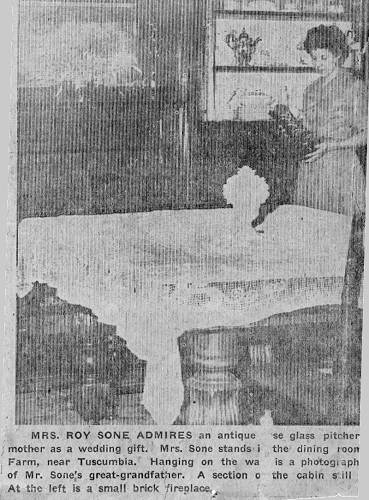
25 Wells Dining Room Mrs. Sone carefully brought out an antique cut glass
cake plate and fruit compote and dainty hand painted china salt and pepper sets. One of
the most unusual pieces is a colorful hand painted milk glass hen given to Mrs. Wells as a
wedding present. Next to the china closet is a small fireplace with an old fashioned
pendulum clock perched on the mantel. Wallpaper of green print landscape and gold
draperies add charm to the room. A chest of drawers made by Mr. Wells sits in one corner
and next to it is a high chair that the Wells children used. On one wall hangs an old
painting of the J.R. Wells, a steamboat owned by the Anchor Milling Company and named for
Mr. Wells who was president of the company.
On another wall in the dining room hangs a photograph of
the log cabin where Mr. Sone's great grandfather, Charles V. Wells, lived when in 1866 he
came from West Virginia to live in Missouri after suffering severe financial loss back
east due to the Civil War. He, however, had begun purchasing property in Miller County as
early as 1842. The elder Mr. Wells owned steamboats that ran on the Ohio and Mississippi
Rivers. After the Civil War he moved to Missouri and picked the spot where he built a log
cabin to live because the view from there of the Osage River reminded him of his home in
West Virginia. A part of the log cabin still stands behind the Wells home as a symbol of
the family's pioneer spirit. Large oak sliding doors separate the dining room and kitchen.
Although the kitchen is completely modern, light fixtures and furniture have been chosen
to carry out the traditional tone of the home.
House Has Six Bedrooms
A hallway leads from the kitchen to the master bedroom
where six of the seven Wells children were born. The furniture is stained oak and is the
original bedroom suite bought in 1889. An antique high back bed stands in one corner of
the room. Mrs. Sone uses a wooden wash stand with a gracefully arching towel rack for a
dresser. A large stained oak bureau stands opposite the bed. Beside the doorway sits a
wicker bottom rocking chair used to rock the Wells babies to sleep. This is only one of
the six large bedrooms in the stately home.
From the bedroom, a hall leads to the foyer at the front
of the house. To the right of the entrance sits a marble topped table. Mrs. Sone has added
a personal touch to the foyer with a beautiful sterling meat cover she bought in London
during a trip she made abroad in 1958. She had the cover cut in half and hung it upside
down against the wall to make a lovely planter.
A long carpeted stairway leads to the second floor. Mrs.
Sone said the Wells children loved to slide down the sturdy oak banister. "At
Christmas," she added, "everyone hangs his stocking on the banister and they
make a very festive sight."
Chandelier Hangs At Top
At the top of the first landing hangs a beautiful cranberry
glass chandelier with long pointed prisms. Mrs. Sone said this is one of the pieces she
likes best in the house. To the right of the stairway is another of her favorites, a small
bathroom (photo 26).
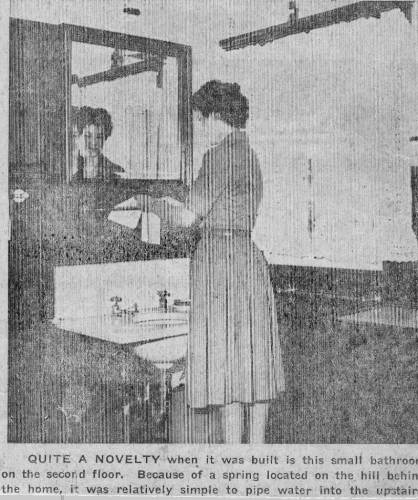
26 Wells Home Bathroom Because there was a spring on the hill behind the
house, it was relatively simple to pipe water into the second floor. So the Wells family
had water inside their home before the hotels in Jefferson City did. There was no standard
size in bathroom fixtures then so Mr. Wells built the marble topped lavatory only slightly
more that 2 ft. from the floor, a convenient size for his petite wife and children. Oak
paneling covers the lower half of the walls. An old fashioned wash stand has been
converted into a lined chest. Eyelet curtains give charm to the room.
The remaining five bedrooms are all on the second floor.
Each room has furniture similar to that of the master bedroom. The tall regal beds add
dignity to each room.
One of the largest bedrooms is used by Mr. Sone as a
study. The double bed stand against one wall and a large stained oak closet is built into
one corner. The sturdy desk used by Mr. Sone was built by his grandfather. On a shelf,
high out of the reach of inquisitive little hands, stands one of Mrs. Wells' favorite
vases bought at the World's Fair in St Louis in 1904. On one wall hangs a large gold
framed photograph of the oldest Wells child, William, as a baby. Crisscross curtains give
a light note to the room.
A striking feature of one of the other bedrooms is a false
front oak fireplace. In this same room stands a small, attractive oak chest which opens
into a child's bed. "We often have weekend guests," Mrs. Sone said, "and if
they have children, they stay in this room." She estimated that 12 guests were the
most they entertained at one time, besides Christmas when the family members can number up
to 25.
Talking Machine As Good As A Radio
She said another one of the most interesting pieces in the
house is a Victor Talking Machine, one of the old time crank up marvels that sports a huge
brass horn. Just to prove it still works she wound it and played a lively foxtrot by Abe
Lyman's California Orchestra called "Talk About My Sweetie."
Perhaps the outstanding feature of the house is found on
the third floor. At the top of a narrowing staircase is a one room schoolhouse (photo 27) where
the Wells Children learned their three R's. The room was built because it was quite a
distance to the local district school (Wright School) and because Mr. Wells, a loyal
Southern gentleman, preferred that his children be taught by a Southern school marm.
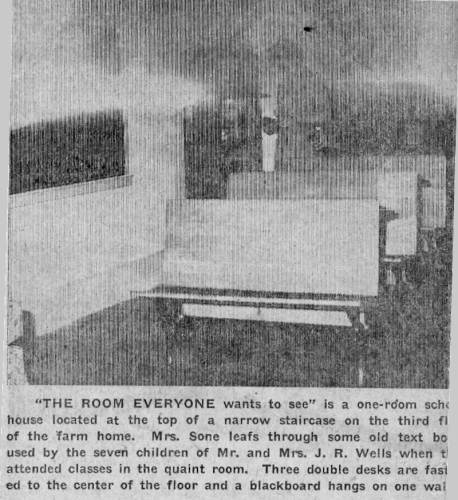
27 Wells Farm School Three of the original double desks remain in the
room and a black board is attached to one wall. Visitors to the tiny room can almost
picture the Wells children bent over their books on blustery winter days or running to the
windows to look out at the first snowfall of the season as it drifted past them to the
yard below.
A glassed in chest at the rear of the room holds some of
their toys…a small steam engine, china tea sets, a miniature flat iron, a stereoscope
and old steamboat tickets. Mrs. Sone said visitors always want to see the schoolroom and
children love to play in it. At the side of an adjoining room is a small round tower that
must have excited the children's imaginations with thought of knights in shining armor
rescuing distressed damsels.
Mrs. Sone admitted that it keeps her busy caring for the
house. "Keeping the yard is a big job, too," she added. In 1949 the big frame
house was moved back about a half mile from its location near Highway 17 after the Osage
River flooded in 1943 and reached the second floor of the building. It now sits at the
foot of a hill and is surrounded by an enormous lawn. In 1953 a sidewalk and patio were
added where the Sones often relax after a busy day.
All in all it is a surprising sight to see such a young
housewife bustling around in such old fashioned surroundings. Mrs. Sone looks out of place
but the success she has had in running her home smoothly and still finding time to teach
kindergarten at Tuscumbia proved she has mastered her job.
The Sones live a 20th century life in a 19th century
house. They have discovered the recipe for mixing old and new and making a happy home.
Thanks Roy and Joyce for that tour taken of the Wells home in 1961.
The following photos are of some farm tools that Roy kept for himself when he left the
farm in 1961: a hand planer (photo 28),
a carpenter's line marker (photo 29),
an old iron (photo 30), an old survey
dial and tripod (photo 31), a wood bin
(photo 32), and an old branding iron (photo 33).
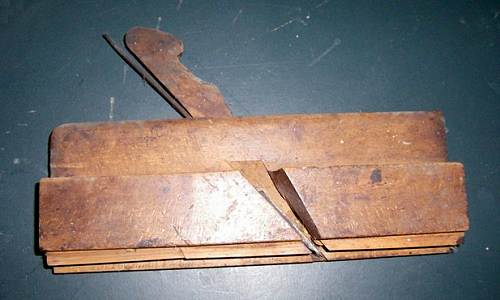
28 Hand Planer
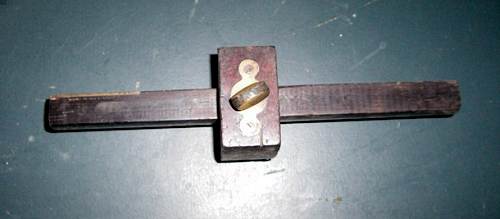
29 Line Marker
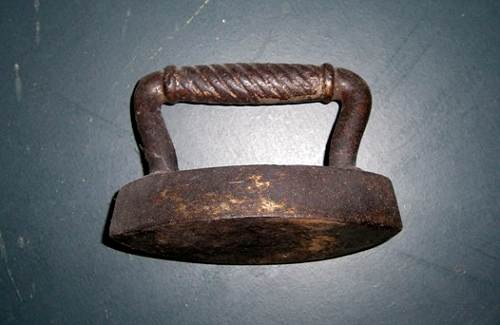
30 Old Flat Iron
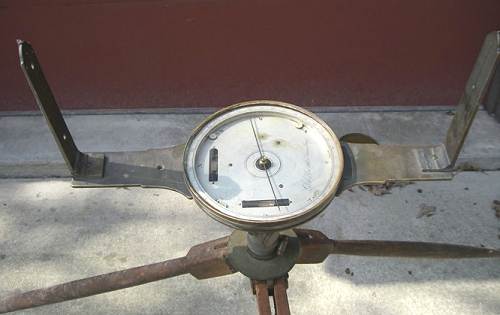
31 Old Survey Instrument and Dial
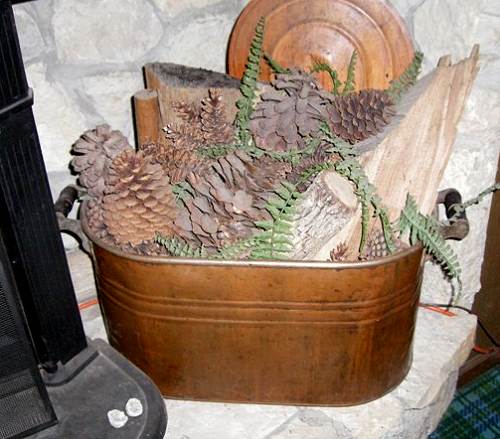
32 Old Boiler used for Laundry
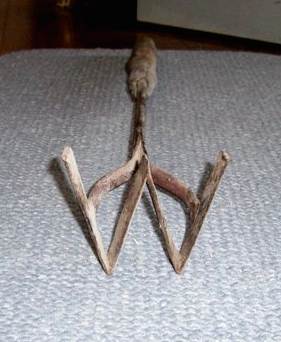
33 Wells Branding Iron Since the Wells family sold the home in the early 1960's it has had several
owners. The Paul Griffiths' who bought the home from the Wells' had it for some twenty
years. The present owners according to the Miller County Assessor's office are Mr. and
Mrs. Ronald Bower. The home today is shown in this recently taken photo (photo 34).
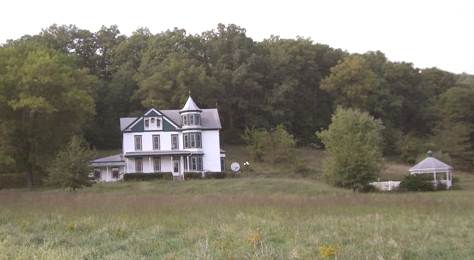
34 J. R. Wells Home
Although the Wells' family history and story of the large Wells home are
interesting enough, the story which most is associated with J.R. Wells is the steamboat
which bore his name, the "J.R. Wells" (photo
35).
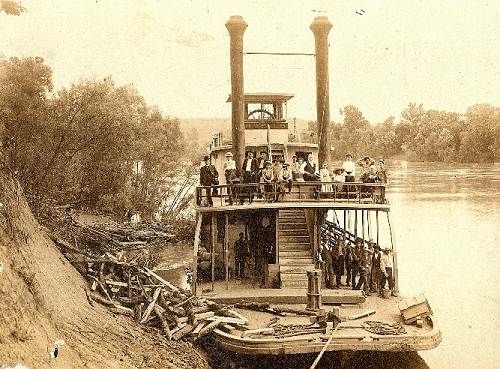
35 J. R. Wells with Passengers Loading Wood In 1898, the Anchor Milling Company, desiring to expand its business,
incorporated naming J.R. Wells as the first president. The company soon afterward began
the construction of a boat at Tuscumbia to be 110 feet long and with a 20-foot beam. This
boat became known as the "J.R. Wells", named after J.R. who as president was one
of the principal stockholders of the Anchor Milling Co. This boat did an extensive
business on the Osage, with Captain John W. Adcock as pilot, and later with Capt. Phillip
F. Hauenstein as pilot. Local crews were employed on this boat, and during the boating
season it was almost continuously engaged in hauling out wheat, barites, lumber,
livestock, kaolin and other products as well as bringing up merchandise from Osage City
and Hoecker. This steamboat is one of the most famous which ever steamed up the Osage and
probably has had more photographs taken of it than any other. Here is a technical
description of it with some interesting history and links taken from the website of
"Steamboat Dave":
Name: J. R. WELLS
Type: Sternwheel, wooden hull towboat/packet. Size: 110.6' X 20' X 4.'
Power: 10's- 4ft. 1 boiler.
Launched: 1897, Tuscumbia, Mo. for Anchor Milling Co.
Destroyed: 1920, Jan. 30, Pelican Bend near St. Charles, Mo., sank.
Area: Osage and Missouri Rivers. Linn Creek, Mo. to St. Louis
Owners: 1897-1909, Osage and Missouri Packet Company
1920, Jan.
30, when sank, owned by Stanton and Jones
Captain: 1897-1909, John W. Adcock, first master and pilot until sold.
At one
time, Capt.
P.F. Hauenstein.
Even a song was written about the J.R. Wells steamboat by Ellis Bray.
And here is one more photo of the famous steamer, the J.R. Wells (photo 37). This photo is interesting in
that the crew is named in the caption. The Bear brothers mentioned were cousins of my
mother. C.B. Wright who is on the second deck occasionally captained the J.R. Wells. The
green colored handwritten writing refers to the incident of another steamer, the Phil
Chappel, being dry docked at the same location because the crew failed to
"sound" the depth before making the landing and as the river lowered the boat
was stranded for quite some time. I obtained this photo from Bamber Wright, nephew of C.B.
Wright, who knew about the incident. I think the photo has had the color added later.
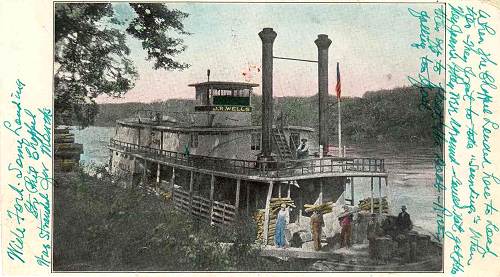
37 J.R. Wells - C. B. Wright Above - Below: Ben and William Bear, Charley Greenup, Will
Nichols and Aaron Wright
Click image for larger view
Work on the renovation of the original museum building continues. We are now putting in
the drop down ceiling. Here is a photo of the "stilt man," Perry Lee (photo 38) who has put in these types of
ceilings for thirty years. Also the guys who have been the major carpenters on the entire
project, Buster Busch and David DeGraffenreid (photo
39), were, as usual, working; at this time they are dry walling and painting.

38 Perry Lee
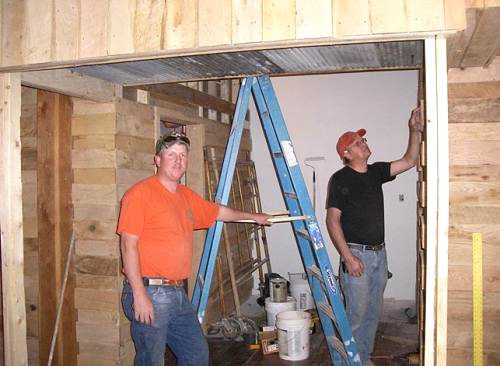
39 Buster Busch and David DeGraffenreid
Last Saturday I represented the Miller County Historical Society and Museum at the
Columbia College Appreciation Day. I took the following photo which shows our display in
the background and some of the guests (photo 40)
who were enjoying a free lunch provided by Columbia College for the event, which
highlights community activities and services.
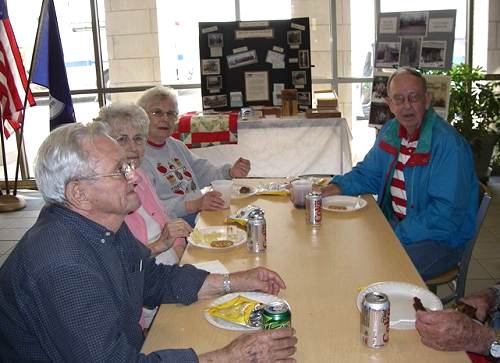
40 Mr. and Mrs. Vernon Brightwell, Doris Porter and Arthur Porter
Finally I am thrilled to announce that the old barber chair from the original barber
shop in Tuscumbia has returned home! Tennyson and Sue Jarrett, who now live in California,
graciously have donated the chair to the museum as well as other memorabilia from the old
Tuscumbia barber shop (barber pole, razor strap, snippers, and other paraphernalia). The
barber chair, a Paidar, was made in Chicago; the barber pole is made of cherry wood. The
fan is very old having been one of the first ceiling mounted fans run by an electric
motor. The chair was brought to the museum from California by Don Helton, nephew of Mrs.
Jarrett (Sue Helton Jarrett) (photo 41).
Members of the local Helton family, especially Ron, Don's brother, helped unload the heavy
chair and carry it into the museum. It was placed in the area where we presently are
constructing a replica of the old Tuscumbia barbershop (photo 42).
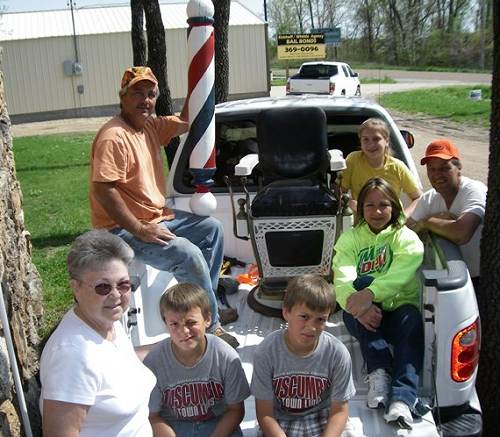
41 Front: Arlene Helton, Benton and Tyler Patterson - Back: Don Helton, Benita Patterson,
Tristen Patterson and Ron Helton
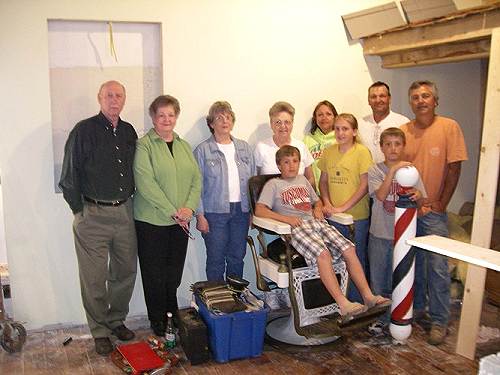
42 Back: Brice and Betty Kallenbach ,Karen Smith, Arlene Helton, Benita Patterson, Ron and
Don Helton - Front: Tyler, Tristen and Benton Helton The first barber in Tuscumbia who was recognized as having that as a profession
was I.N Reed who, according to Louie Clarke Lawson, barbered in the 1880's. No one seems
to know much about him. Edgar Hicks was the first barber any of my mother's generation
really remembers which would have been in the 1920's and 1930's. At that time a license
from the state wasn't necessary to cut hair. Edgar barbered in the old barber shop in
Tuscumbia along the river bluff until Glen Wyrick and his son, Bob, bought it in 1936.
They had the shop when the flood of 1943 occurred. The water was so high and swift that
the entire post office building, which was next to the barber shop, floated away down to
the bridge where it hung up. The barber shop floated down to the corner three story stone
building which at that time was owned by Jim Sweeney. It hung up there and with great
effort, was pulled by several boats back to a location slightly more west along the bluff
than before, next to the Spearman building which later became the next post office. In
approximately 1944 Wes Condra bought the barber shop and ran it until 1966 when he
suddenly died of a heart attack. Russell, Wes's son, sold it then to Tennyson Jarrett who
barbered for about two years before moving to California. Tennyson took the chair and some
other paraphernalia with him when he moved to California, but after arriving there decided
not to barber and therefore, stored the chair in his home.
The old barber shop building still exists in Tuscumbia located under the hill along the
riverside drive having been remodeled and enjoyed as a residence by Beverly Pendleton.
Next week I will show some photos of how Beverly, who is a cosmetologist and has a salon
next door to her home, has significantly beautified that area of Tuscumbia.
That's all for this week.
|



